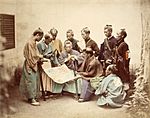Genbun facts for kids
 |
|---|
|
The Genbun (元文) era was a special time period in Japanese history. It was like a way to count years, similar to how we use years like 2023 or 2024. This era came after the Kyōhō period and before the Kanpō period.
The Genbun era lasted from April 1736 to February 1741. During this time, the emperor was Emperor Sakuramachi.
Contents
Starting the Genbun Era
A New Era Begins
- 1736: The Genbun era officially started. This happened to celebrate Emperor Sakuramachi becoming the new emperor. The word Genbun means "Original civility," which sounds quite formal! The previous era, Kyōhō, ended, and Genbun began on the 21st day of the 4th month in what was then the 21st year of Kyōhō.
Important Events of the Genbun Era
Money and Coins
- 1736 (Genbun 1): The Japanese government, called the shogunate, made an important rule about money. They announced that only special copper coins could be used across the country. These coins had the character 文 (pronounced bun) on them. This is the same character found in the name of the Genbun era!
- 1739 (Genbun 4): Some metalworkers in Edo (which is now Tokyo) were asked to make iron coins. These new iron coins were also meant to be used all over Japan.
Sky and Ceremonies
- 1737 (Genbun 2, 11th month): People noticed a comet in the western sky. A comet is a small, icy body that orbits the sun and can sometimes be seen from Earth.
- 1738 (Genbun 3): The emperor performed special Shinto ceremonies called Daijō-sai. These were important religious rituals for the emperor.
- January 11, 1741 (Genbun 5, 24th day of the 11th month): Another important ceremony, the Niiname-matsuri, was performed. This ceremony had not been held for 280 years, making it a very rare and significant event!
Notable Incidents
- 1739 (Genbun 4): A lord named Hosokawa Etchū-no-kami was killed in Edo Castle. The person who killed him, Itakura Katsukane, was ordered to take his own life as punishment. However, the powerful shōgun, Tokugawa Yoshimune, stepped in. He helped make sure that Itakura Katsukane's family would not suffer too much because of the incident.
- August 8, 1740 (Genbun 5, 16th day of the 7th month): There were big floods in Heian-kyō (which is now Kyoto). The famous Sanjo Bridge was washed away by the strong waters.
Related Information
- National Diet Library, "The Japanese Calendar"
| Genbun | 1st | 2nd | 3rd | 4th | 5th | 6th |
|---|---|---|---|---|---|---|
| 1736 | 1737 | 1738 | 1739 | 1740 | 1741 |
| Preceded by: Kyōhō |
Era or nengō: Genbun |
Succeeded by: Kanpō |

All content from Kiddle encyclopedia articles (including the article images and facts) can be freely used under Attribution-ShareAlike license, unless stated otherwise. Cite this article:
Genbun Facts for Kids. Kiddle Encyclopedia.
